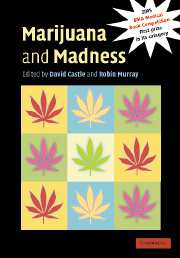Book contents
- Frontmatter
- Contents
- List of contributors
- Foreword
- Preface
- 1 The cannabinoid system: from the point of view of a chemist
- 2 How cannabis works in the brain
- 3 Acute and subacute psychomimetic effects of cannabis in humans
- 4 The association between cannabis use and depression: a review of the evidence
- 5 Cannabis and psychosis proneness
- 6 Is there a specific ‘cannabis psychosis’?
- 7 Cannabis as a potential causal factor in schizophrenia
- 8 Cannabis abuse and the course of schizophrenia
- 9 The endogenous cannabinoid system in schizophrenia
- 10 Cannabinoid ‘model’ psychosis, dopamine–cannabinoid interactions and implications for schizophrenia
- 11 Motives that maintain cannabis use among individuals with psychotic disorders
- 12 Addressing cannabis abuse in people with psychosis
- 13 Residual cognitive effects of long-term cannabis use
- Index
- References
3 - Acute and subacute psychomimetic effects of cannabis in humans
Published online by Cambridge University Press: 07 December 2009
- Frontmatter
- Contents
- List of contributors
- Foreword
- Preface
- 1 The cannabinoid system: from the point of view of a chemist
- 2 How cannabis works in the brain
- 3 Acute and subacute psychomimetic effects of cannabis in humans
- 4 The association between cannabis use and depression: a review of the evidence
- 5 Cannabis and psychosis proneness
- 6 Is there a specific ‘cannabis psychosis’?
- 7 Cannabis as a potential causal factor in schizophrenia
- 8 Cannabis abuse and the course of schizophrenia
- 9 The endogenous cannabinoid system in schizophrenia
- 10 Cannabinoid ‘model’ psychosis, dopamine–cannabinoid interactions and implications for schizophrenia
- 11 Motives that maintain cannabis use among individuals with psychotic disorders
- 12 Addressing cannabis abuse in people with psychosis
- 13 Residual cognitive effects of long-term cannabis use
- Index
- References
Summary
Cannabis sativa has been used for centuries for both its medicinal and psychomimetic effects. This chapter outlines the acute and subacute psychomimetic effects of cannabis in humans. Animal experiments with cannabis are not addressed here; the interested reader can find an account of such studies in Chapters 1 and 2 or refer to Adams and Martin (1996) or Chaperon and Thiebot (1999). Similarly, cannabis-associated psychotic disorders in humans are not dealt with here, as these are discussed in Chapters 5–7.
As we shall describe, the response of most people to cannabis is fairly stereotyped. Having said this, the experience of intoxication with any psychomimetic substance is influenced, inter alia, by dose; previous experience (and hence expectation of effect); the personal characteristics of the user (e.g. personality); and the context in which the drug is taken (O'Brien, 1996). Dose is particularly problematic with use of the plant C. sativa, as the proportional content of the major psychoactive compound (Δ9-tetrahydrocannabinol, or THC) varies widely between different strains of the plant, as well as being dependent upon the conditions under which the plant was cultivated. Furthermore, the part of the plant or the type of plant product consumed also affects the amount of THC ingested: for example, cannabis resin has a THC content of up to 10 times that of the traditional cigarette (Ashton, 2001).
- Type
- Chapter
- Information
- Marijuana and MadnessPsychiatry and Neurobiology, pp. 41 - 53Publisher: Cambridge University PressPrint publication year: 2004
References
- 3
- Cited by



